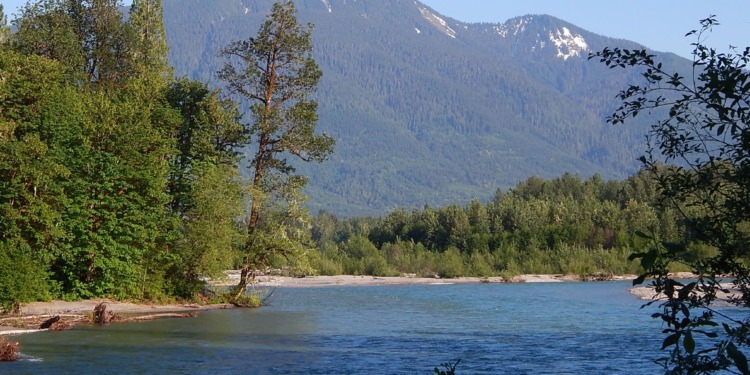Rivers have long played a vital role in the survival of human, animal, and plant life. World Rivers Day was established to draw attention to this importance, and the threats that they are currently facing. It falls on the fourth Sunday of September, making its most recent observation yesterday.
Mark Angelo, Canadian river conservationist and writer, can be credited for the founding of World Rivers Day. He proposed the concept to the UN following the success of a British Columbia Rivers Day he organised. Since it aligned with the UN’s theme at the time of “Water for Life,” it was received positively and the first World Rivers Day took place in 2005.
The “celebration of the world’s waterways” is currently observed in 100 countries around the globe, its intentions being to promote awareness of the value of rivers, the threats posed to them, and how they can be protected.
As we mark World River Day today, reflect on how we can protect our rivers, here is the Ankobra River showing its beauty and ugly state. pic.twitter.com/zXr7fp02Gy
— Edem Srem (@Afrikanticha3) September 25, 2022
The historic link between rivers and human society can be seen in the earliest settled civilizations in existence around 5000 years ago, most of which were located along the banks of large rivers. For example:
- The Egyptian civilisation was situated along the Nile;
- The Sumerians existed between the Tigris and Euphrates rivers in modern-day Iraq;
- The Indus Valley civilisation prospered along the alluvial plain of the Indus river;
- Ancient Chinese civilisations formed around the Yellow and Yangtze rivers.
The importance of rivers to these civilisations related to their steady supply of drinking water, the transportation links they forged, the ability to fish within them, and the crops provided by the fertile soil at their banks.
Despite the millennia that have passed since these civilisations, rivers remain just as valuable.
Today, 60 million people’s livelihoods directly depend on the heath of rivers and the drinking water of nearly two billion individuals – including around two-thirds of the US – is sourced from rivers and streams.
Today is World Rivers Day. Our rivers are crucial sources of human & ecological survival. One way to conserve rivers is by planting the right type of trees along riverbanks. Root systems of trees help stabilise the soils from erosion and create stability and prevent flooding. pic.twitter.com/Qs1WlPvtm3
— Free Tree Society KL (@freetreesociety) September 25, 2022
Beyond the obvious value rivers hold for humanity, they are also some of the most biodiverse areas in the world, as is highlited by the theme of this year’s World Rivers Day – “the importance of rivers to biodiversity.”
Fish, amphibians, birds, insects, reptiles, and invertebrates are all examples of animals that depend on rivers either as their habitat or their source of food.
The natural, irregular shape of riverbeds and banks is crucial to this aquatic biodiversity as it allows fish, amphibians, and insects to hide from predators. Natural water flows also enable biological purification processes that help to keep the water clean.
Consequently, manmade bodies of water will never be able to function as a suitable replacement.
Related Articles: Europe’s Worst Drought in at Least 500 Years Continues | How Environmental Racism Has Caused a Water Crisis in Mississippi
Despite this wide variety of reasons our rivers are so crucial and worthy of protection, they are being left to suffer as a result of both climate change and dam building.
Climate change, firstly, is reducing aquatic biodiversity by warming rivers and increasing the frequency of drought and flood events. Shifting precipitation levels also leave less water to dilute pollutants such as wastewater and agricultural run-off.
Perhaps the lesser-known evil facing rivers though is dam building.
Large dams cut off migration routes, isolate species, and interrupt the flow of nutrients to downstream habitats. They also alter the nature of a river’s estuary, where many fish spawn, and make the entire ecosystem more vulnerable to other threats like climate change.
The Three Gorges Dam in China – the world’s largest hydroelectric facility – has demonstrated these consequences.
Whilst it promised to play a beneficial role in flood control and energy supply, it has in fact resulted in landslides, water quality decline, and ecological harm as a result of lowered downstream water levels and reduced numbers of plankton. It is reported that one example of the latter consequence is the extinction of the baiji dolphin that had previously thrived in the Yangtze River.
The deterioration of our rivers is marked. In England, for example, only around 14% of rivers meet good ecological standards.
However, we are certainly not past the point of no return, there are many steps that can be taken to help protect and recover these vital natural gifts:
In terms of dams, it is important that planning processes and standards are improved, and that the most harmful dams are decommissioned.
Actions that can be taken at home include limiting pesticide and non-biodegradable cleaning product use, volunteering for a local river clean up event, and taking small steps to reduce how much water your household consumes.
As Mark Angelo, World River Day’s founder, asserts, “rivers are the arteries of our planet; they are lifelines in the truest sense.” Although they deserve protection every day of the year, World Rivers Day is a welcome reminder of just how much our health relies on theirs.
Editor’s Note: The opinions expressed here by Impakter.com columnists are their own, not those of Impakter.com. — In the Featured Photo: Prairie Mountain and Sauk River. Photo Credits: Wikimedia Commons.








